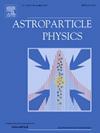轴子量子涨落,暗能量,还有哈勃张力
IF 2.9
3区 物理与天体物理
Q1 ASTRONOMY & ASTROPHYSICS
引用次数: 0
摘要
宇宙学常数现在是标准ΛCDM模型的一个基本组成部分,它的值受到与经验数据的一致性的限制。尽管它在现代宇宙学中很重要,但我们仍然不了解它的起源。对量子真空涨落对真空能量的贡献(考虑到它是宇宙常数的来源)的简单计算得出的预测值比观测值大120个数量级。这就提出了物理学和宇宙学中最著名的未解决问题之一。本文讨论了一个具有普朗克因子的宇宙微波背景的量子热涨落模型。我们研究了玻色子场的波动,并证明如果它们对应于粒子静止质量在1兆电子伏的几分之一范围内的轴子场,它们可以匹配真空能量密度。这一质量范围与Peccei-Quinn轴子目前的质量界限一致,这些轴子是由解释强相互作用中CP守恒的自发对称破断产生的,也与星系晕中轴子质量的估计和使用Josephson结对夏皮罗阶跃异常进行的实验一致。我们还表明,该模型可以澄清哈勃张力争论,即基于宇宙微波背景的哈勃参数测量与使用低红移观测的哈勃参数测量之间的统计显著差异。本文章由计算机程序翻译,如有差异,请以英文原文为准。
Axionic quantum fluctuations, dark energy, and the Hubble tension
The cosmological constant is now a fundamental ingredient of the standard ΛCDM model, and its value is constrained by concordance with empirical data. Despite its importance in modern cosmology, we still do not understand its origin. A naive calculation of the contribution of the quantum vacuum fluctuations to vacuum energy (considering it to be the source of the cosmological constant) yields predictions 120 orders of magnitude larger than observations. This poses one of the most celebrated unsolved problems in physics and cosmology. This work discusses a model of quantum-thermal fluctuations of the cosmic microwave background with a Planck factor. Fluctuations of a bosonic field are studied, and we show that they could match the vacuum energy density if they correspond to an axionic field with a particle rest mass in the range of a fraction of a meV. This mass range is in agreement with present bounds on the mass of the Peccei–Quinn axions arising from the spontaneous symmetry breaking that explains CP conservation in strong interactions, as well as estimations of the mass of axions in the galactic halo and experiments on Shapiro step anomalies using Josephson junctions. We also show that this model can clarify the Hubble tension debate, i.e., the statistically significant discrepancy between measurements of the Hubble parameter based upon the cosmic microwave background and those using low redshift observations.
求助全文
通过发布文献求助,成功后即可免费获取论文全文。
去求助
来源期刊

Astroparticle Physics
地学天文-天文与天体物理
CiteScore
8.00
自引率
2.90%
发文量
41
审稿时长
79 days
期刊介绍:
Astroparticle Physics publishes experimental and theoretical research papers in the interacting fields of Cosmic Ray Physics, Astronomy and Astrophysics, Cosmology and Particle Physics focusing on new developments in the following areas: High-energy cosmic-ray physics and astrophysics; Particle cosmology; Particle astrophysics; Related astrophysics: supernova, AGN, cosmic abundances, dark matter etc.; Gravitational waves; High-energy, VHE and UHE gamma-ray astronomy; High- and low-energy neutrino astronomy; Instrumentation and detector developments related to the above-mentioned fields.
 求助内容:
求助内容: 应助结果提醒方式:
应助结果提醒方式:


